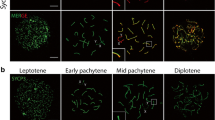Abstract
The dominant X-autosome heterozygous translocation mutant mnT6 of the nematode Caenorhabditis elegans has an X chromosome that has been reduced in size by 40%, yet the remainder of the bivalent pairs effectively at pachytene and has a synaptonemal complex (SC) that has a normal appearance. Six SCs are present in pachytene nuclei of this mutant which correspond to a haploid value of n=6. Nondisjunction of the X chromosome occurs at a rate of 37% and there are no ‘Disjunction Regulator Regions’ (DRR) in this him (high incidence of males) mutant. This is consistent with the notion that DRRs either promote disjunction or inhibit nondisjunction of the X chromosome. Their occurrence in pachytene nuclei is independent of the mechanism responsible for nondisjunction, i.e. point mutations as in him-8 versus chromosomal aberrations as in mnT6. Although an SC is present along the entire length of the X chromosome, crossover suppression is observed in mnT6.
Similar content being viewed by others
References
Goldstein P (1982) The synaptonemal complexes of Caenorhabditis elegans: Pachytene karyotype analysis of male and hermaphrodite wild-type him mutants. Chromosoma 86:159–178
Goldstein P (1984a) Triplo-X hermaphrodites of Caenorhabditis elegans: Pachytene karyotype analysis, synaptonemal complexes and pairing mechanisms. Can J Genet Cytol 26:13–17
Goldstein P (1984b) Sterile mutants in Caenorhabditis elegans: The synaptonemal complex as an indicator of the stage-specific effect of the mutation. Cytobios 39:101–108
Goldstein P (1984c) The synaptonemal complexes of Caenorhabditis elegans: Pachytene karyotype analysis of the rad-4 radiation sensitive mutant. Mutat Res 129:339–343
Goldstein P, Slaton DE (1982) The synaptonemal complex of Caenorhabditis elegans: Comparison of wild type and mutant strains and pachytene karyotype analysis of wild type. Chromosoma 84:585–597
Hartman P, Herman RK (1982) Radiation-sensitive mutants of Caenorhabditis elegans. Genetics 102:159–178
Herman RK, Kari CK, Hartman PS (1982) Dominant X-chromosome mutants of Caenorhabditis elegans. Genetics 102:379–400
Hodgkin J, Horvitz HR, Brenner S (1979) Nondisjunction mutants of the nematode Caenorhabditis elegans. Genetics 91:67–94
Mahadevaiah S, Mittwoch U, Moses MJ (1984) Pachtene chromosomes in male and female mice heterozygons for Is (7; 1) 40 H insertion. Chromosoma 90:163–169
Mounier N, Brun J (1980) A cytological analysis of sterile mutants in Caenorhabditis elegans. Can J Genet Cytol 22:391–403
Riddle DL, Swanson MM (1982) The nematode Caenorhabditis elegans. Genet Maps 2:244–258
Roberts PA (1970) Screening for X-ray induced crossover supressor in Drosphila melanogaster: prevalence and effectiveness of translocations. Genetics 65:429–448
White MJD (1973) Animal cytology and evolution. 3rd. ed. Cambridge University Press, London
Author information
Authors and Affiliations
Rights and permissions
About this article
Cite this article
Goldstein, P. The synaptonemal complexes of Caenorhabditis elegans: the dominant him mutant mnT6 and pachytene karyotype analysis of the X-autosome translocation. Chromosoma 93, 256–260 (1986). https://doi.org/10.1007/BF00292746
Received:
Revised:
Issue Date:
DOI: https://doi.org/10.1007/BF00292746




